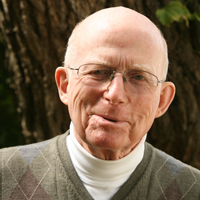Scott Donaldson writes the real lives of famous authors
“She kids me that ‘They’re all 20th century WASP males,’ “ he confessed while gently picking apart a sweet roll.
That’s certainly one way to characterize Ernest Hemingway, F. Scott Fitzgerald and John Cheever.
Another might be to include them at the top of the list of dysfunctional giants of American literature. Suicide, alcoholism, drug overdoses, marital infidelity. . .
But they’re more famously responsible for much of the exemplary American literature from the 20th century. The Great Gatsby. Tender Is The Night. The Old Man and The Sea. To Whom the Bell Tolls. The Swimmer. The Wapshot Chronicle.
 Donaldson came to William & Mary as an assistant professor of English in 1966 and stayed 28 years. The Donaldson Writer-in-Residence Program, established in 1971 and still going strong, is funded in part by an endowment from Scott and Vivian.
Donaldson came to William & Mary as an assistant professor of English in 1966 and stayed 28 years. The Donaldson Writer-in-Residence Program, established in 1971 and still going strong, is funded in part by an endowment from Scott and Vivian.Tonight at 7 p.m. in Ewell Hall, Donaldson returns to participate in the Patrick Hayes Writers Series, sponsored by the Patrick Hayes Endowment and the English Department. Joining Donaldson, who will discuss his new book “Fitzgerald and Hemingway: Works and Days,” are Carol Sklenicka and W&M Writer-in-Residence Blake Bailey.
Blake has recently published biographies of Richard Yates (Revolutionary Road) and John Cheever. Sklenicka is about to publish a biography of short-story giant Raymond Carver. A reception and book signing will follow the program.
Donaldson has also written biographies of Archibald MacLeish and poets Winfield Townley Scott and Edwin Arlington Robinson. But it is Fitzgerald and Hemingway, neither of whom he ever met, who have monopolized his time and energies over the last four decades - three biographies, contributions to three volumes of criticism and 42 articles.
“I guess I have an identification with them because of their midwestern origins and mine,” explained Donaldson, a native of Minneapolis who spent 10 invaluable years as a reporter for the Minneapolis Star before turning in another direction. ”Fitzgerald was from St. Paul. I guess I was an early worshipper of Hemingway; I did my senior thesis at Yale on T he him.”
Donaldson, who has been tapping a plastic mug in a light staccato that seems to match his mood, suddenly drops a bombshell.
“My mother, who died very young - before I could ask her this - might very well have danced with Fitzgerald,” the soon-to-be 81 Donaldson theorizes. “She went to St. Paul Central, which was the high school closest to him. He lived in St. Paul. He was the same age. She was attractive; he was attractive. Who knows? It might have been.”
That may be the only morsel regarding Fitzgerald or Hemingway that Donaldson hasn’t nailed down with incontrovertible certainty. That decade as a reporter provided him with heightened research and interviewing techniques. It also led to him developing a “judicious skepticism” he employed to strip away the “shields” Hemingway put up to deal with his depression, alcoholism and unwanted celebrity.
“Hemingway adapted the persona of the rugged, macho outdoorsman, fighter, warrior, lover, bullfight aficionado, boxer - all of these things as opposed to someone who sat in his room and typed out his copy,” Donaldson said. “That, of course, is what he had to do.
“A lot of it was a shield against his own sensitivity . . . if the public and those telling the stories to the public are depicting him as macho character, it’s a way of evading his own tortured sensibility. He certainly was terribly depressed often, which finally led to a suicide that is genetic to his family.
“Also, he thought if he let the journalists get too close to the fact of the way he lived his life, as opposed to the life he invented, they’d be robbing him of material he might one day want to use in his own fiction.”
Commenting on Donaldson’s latest book, Jennie Kassanoff of Barnard College wrote “one is struck anew by Scott Donaldson’s kinship with the authors.” As someone who admits to “living someone else’s life as a biographer,” does Donaldson ever feel remorse about portraying their often chronic flaws? Is there a wart too ugly to expose?
“There are stories that I know that are not in my books, and that I would not put in my books,” he admitted. “If it’s really peripheral, nasty but peripheral, I try to leave it out. Otherwise, I don’t feel guilty trying to get at the way people were, even if that way was pretty unpleasant. You try to catch people at their best and their worst, and hope the reader can get a balance and figure out what these guys are like.”
In the introduction to “Fitzgerald and Hemingway,” Donaldson writes with great affection about his tenure at the College. He and Vivian so enjoy visiting Williamsburg that they have talked about a possible return.
“If I hadn’t come to William & Mary, a great many things would have been different in my life,” he said. “I’m glad I did.”
So should the students in the College’s writing program. They receive a chance at learning from a vast array of successful authors spanning many different genres.
“The writer’s often the wild man or woman on campus, especially the creative writer, but that’s healthy, too,” Donaldson said. “They’ve been out there in the real world and they’ve managed to make some kind of success out of their work.
“Saul Bellow, when he taught at Minnesota, used to say about students, ‘I can lather you up, but you’ve got to shave yourself.’ Maybe these writers in residence here can supply the lather.”














